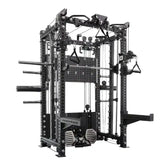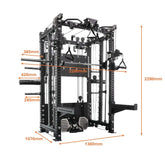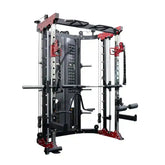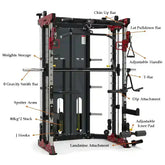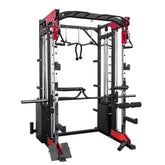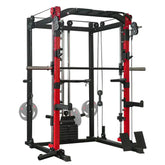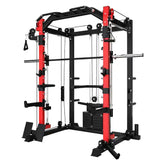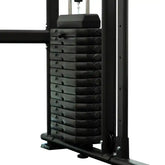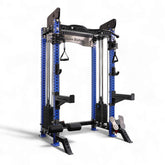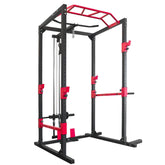Train Hard, Stay Consistent: How a Home Gym Builds Real Muscle
A home gym isn’t just about convenience — it’s about consistency. With the right mindset, structured training, and quality equipment, you can build serious muscle, strength, and self-discipline right where you live.
Build muscle and discipline from home — your home gym is more than equipment; it’s the foundation of consistency and long-term results.
Why Your Home Gym Is More Than Just a Space

When I first built my home gym, it wasn’t about saving time — it was about removing excuses.
As a bodybuilder and coach, I’ve learned that the people who get results aren’t always the ones with the most equipment — they’re the ones who show up consistently.
A home gym gives you that power. No traffic, no waiting for machines, no distractions — just you, your equipment, and your goals.
For me, it’s also mental. Training at home keeps me grounded and reminds me why I started this journey 15 years ago: to build strength, both physical and mental.
If you’re ready to take control of your fitness from your own space, explore the home gym collection at Alpha Go Fitness — durable, space-efficient setups built for real results.
The Real Benefit: Consistency Builds Muscle
You don’t need marathon training sessions to see progress — you just need consistency. That’s where a home gym truly shines.
When I coach athletes who move from commercial gyms to training at home, their consistency skyrockets. Why? Because convenience removes resistance — no travel, no waiting, no excuses.
The 3 Pillars of Home Gym Success:
-
Consistency: Even 30 minutes a day adds up faster than one marathon session a week.
-
Intensity: Focus beats duration. Apply progressive overload — lift smarter, not longer.
-
Recovery: Respect your rest days, fuel your body, and prioritise quality sleep.
Coach’s Insight: Your home gym gives you the freedom to show up daily — and that’s the real secret behind strength, muscle growth, and lasting results.
Building Muscle with Home Gym Equipment
Let’s focus on what really matters — results.
Here’s how you can target each major muscle group using core equipment from your home gym setup.

Upper Body: Dumbbell Set + Cable Machine
-
Flat Dumbbell Press: Builds chest and triceps while improving balance and control.
-
One-Arm Row: Strengthens your back muscles, especially the lats and rhomboids.
-
Cable Tricep Pushdown: Isolates the arms for strength and definition.
The dumbbell-and-cable combination offers the same training variety as a commercial gym — but with zero wait time, complete freedom, and long-term consistency.
Lower Body: Squat Rack + Leg Press Machine
-
Back Squat: The ultimate builder of strength and lower-body size.
-
Bulgarian Split Squat: Great for developing balance and single-leg strength.
-
Leg Press: Perfect for hypertrophy-focused sessions and building quad volume.
Your squat rack is the anchor of any lower-body program — no serious lifter skips it. Paired with a leg press machine, it creates the ideal balance between power and muscle isolation.
Core & Conditioning: Rowing Machine + Bodyweight
-
Renegade Rows: Strengthen your core, lats, and stability simultaneously.
-
Rowing Intervals: Boost endurance and cardiovascular performance.
-
Plank + Cable Rotation: Train a strong, functional core that supports every lift.
Consistency in these compound and functional movements builds not only muscle, but also durability, balance, and performance.
Explore Alpha Go Fitness to find squat racks, rowing machines, and accessories built for strength and longevity.
Nutrition: The Home Gym Edge
When you train from home, you control more than your workouts — you control your kitchen. That’s your ultimate advantage.
Protein at Every Meal
Fuel your training and repair muscle with consistent protein intake.
Aim for 25–40 g of protein per meal from sources such as chicken, eggs, Greek yoghurt, or a simple post-workout shake.
Plan Simple, Eat Smart
Meal-prep twice a week and stick to balanced plates that include lean protein, complex carbs, and healthy fats. Keeping nutrition simple makes it easier to stay consistent.
Hydrate Before, During, and After
Training at home can make it easy to forget water breaks. Keep a bottle within reach and sip regularly to maintain performance and recovery.
Coach’s Note: I prep my meals the same way I plan my workouts — simple, repeatable, and performance-focused, not perfect. Smart nutrition turns your home gym into a complete training system for results that last.
The Psychology of the Home Gym
When I built my home gym, something changed — it stopped being just about aesthetics and started being about ownership.
Your home gym becomes your sanctuary:
-
It’s where you test your limits.
-
It’s where you win small battles every day.
-
It’s where you train because you choose to, not because you “have to.”
Discipline grows in environments you control — and that’s exactly what a home gym provides. It removes excuses, builds consistency, and reinforces the mindset that you’re in charge of your results.
Sample 4-Day Home Gym Training Split
Here’s a simple but effective home gym program designed to balance intensity, recovery, and total-body development using your Alpha Go Fitness equipment:
|
Day |
Focus |
Key Exercises |
|
Monday |
Push (Chest, Shoulders, Triceps) |
Dumbbell Press, Overhead Press, Cable Pushdowns |
|
Tuesday |
Pull (Back, Biceps) |
One-Arm Dumbbell Row, Pull-Ups, Dumbbell Curls |
|
Thursday |
Legs |
Squat, Romanian Deadlift, Leg Press |
|
Saturday |
Conditioning & Core |
Rowing Machine, Planks, Weighted Crunches |
This structure keeps training volume high, recovery balanced, and progress consistent — ideal for athletes and home lifters who want real results without sacrificing flexibility.
Coach’s Tip: You don’t need endless variety — you need structure and intensity. Four disciplined sessions a week in your home gym can rival any commercial setup for building strength, balance, and endurance.
Common Home Gym Mistakes to Avoid
-
Overcomplicating the setup: You don’t need 20 machines — start with a squat rack, dumbbells, and a bench.
-
Skipping progressive overload: Keep track of weights, reps, and recovery time.
-
Neglecting nutrition: You can’t build on an empty tank.
Your home gym should simplify your life, not stress it. Focus on consistency and progression over perfection.
Why Home Training Builds Lifelong Strength
Training at home teaches a kind of discipline no public gym can match. There’s no applause, no competition — just you versus your own standard.
As someone who’s trained in world-class facilities and tiny garages alike, I’ve learned one truth:
The strongest athletes aren’t made by their environment — they’re built by their commitment.
With a solid plan, balanced nutrition, and quality equipment, your home gym can shape not only your body but also the mindset of a champion.
Ready to create your own training space? Our team can help you choose the perfect setup — from dumbbells to full home gym packages — designed for real performance. Start checking your equipment here or contact us now.
Frequently Asked Questions
What’s the best equipment to start a home gym with?
If you’re new to training at home, start with the essentials: a dumbbell set, an adjustable bench, and a squat rack. These three pieces allow you to perform full-body workouts safely and effectively.
Can I build serious muscle at home without machines?
Absolutely. Many athletes and even competitive bodybuilders have built muscle using just free weights like dumbbells, barbells, and resistance bands.
What’s the difference between a squat rack and a Smith machine?
A squat rack gives you freedom of movement, making it great for developing real-world strength and balance. A Smith machine has a fixed bar path, providing extra safety and control — perfect for solo training and hypertrophy work. Both are valuable tools: use a squat rack for compound lifts and a Smith machine for isolation or high-volume sets.
How much space do I need for a home gym setup?
Most home gyms fit comfortably in about 3m x 3m of space — enough for a squat rack, bench, and dumbbell storage. If you’re adding a cable machine or foldable Pilates reformer, aim for at least 1–2m of clearance around your equipment for safe movement.
Are adjustable dumbbells worth it?
Yes — adjustable dumbbells replace multiple fixed-weight sets, saving both space and cost. They’re perfect for progressive training, allowing you to switch easily between lighter weights for shoulders and heavier ones for compound lifts.

